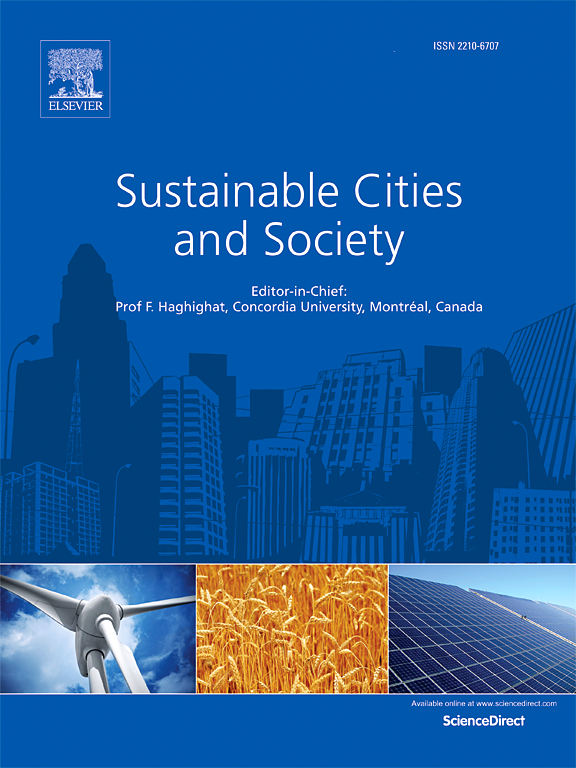An innovative framework combining a CNN-Transformer multiscale fusion network and spatial analysis for cycleway extraction using street view images
IF 10.5
1区 工程技术
Q1 CONSTRUCTION & BUILDING TECHNOLOGY
引用次数: 0
Abstract
Cycling is a global activity promoting environmental sustainability and health benefits. Many cities have invested in developing dedicated bike paths. Data about these cycleways, often missing in road databases, form the cornerstone of cycling experience assessment and sustainable urban development planning. Street view images (SVIs) provide detailed street-level information, contributing significantly to extracting these cycleway infrastructure data. However, automatic methods for this task are currently sparse. In this study, we propose an innovative framework combining deep learning with post-processing to extract geo-tagged cycleways from SVIs. First, an innovative neural network, SWDE-Net, is proposed to segment various types of cycleways from SVIs. SWDE-Net integrates the strengths of Convolutional Neural Networks (CNNs) in handling local features and Transformers in managing global dependencies within the DeepLabv3+ encoder-decoder framework. A Cross-Contextual Atrous Spatial Pyramid (CC-ASP) module for enhanced multiscale features and a Spatial Global-local Fusion (SGLF) module for precise spatial information. Following cycleway extraction using SWDE-Net, a post-processing approach integrating roadside determination and majority voting is proposed to geotag the extracted cycleways to the road network. Experimental results show that SWDE-Net achieved a mean Intersection over Union (mIoU) of 85.57 % on the constructed cycleway dataset outperformed the state-of-the-art models. Applied to Ghent (Belgium), the framework achieved a geometric correctness of 86.25 %. Evaluations in two additional cities further illustrate the proposed framework's robustness. Therefore, this study provides a highly flexible and robust method for automatically constructing bicycle infrastructure datasets from SVIs, facilitating the development of active mobility solutions in urban environments.
结合CNN-Transformer多尺度融合网络和空间分析的创新框架,用于从街景图像中提取自行车道
骑自行车是一项促进环境可持续性和健康效益的全球性活动。许多城市已经投资开发专用自行车道。关于这些自行车道的数据,往往在道路数据库中缺失,构成了骑行体验评估和可持续城市发展规划的基石。街景图像(SVIs)提供详细的街道信息,对提取这些自行车道基础设施数据有重要贡献。然而,用于此任务的自动方法目前很少。在这项研究中,我们提出了一个结合深度学习和后处理的创新框架,从svi中提取地理标记的自行车道。首先,提出了一种创新的神经网络SWDE-Net,用于从svi中分割各种类型的自行车道。SWDE-Net集成了卷积神经网络(cnn)在处理局部特征方面的优势,以及在DeepLabv3+编码器-解码器框架中管理全局依赖关系的transformer的优势。一个跨上下文属性空间金字塔(CC-ASP)模块用于增强多尺度特征,一个空间全局-局部融合(SGLF)模块用于精确的空间信息。在使用SWDE-Net进行自行车道提取之后,提出了一种结合道路决定和多数投票的后处理方法,将提取的自行车道地理标记到道路网络中。实验结果表明,在构建的自行车道数据集上,SWDE-Net实现了85.57%的平均交汇率(mIoU),优于最先进的模型。应用于根特(比利时),该框架的几何正确性达到86.25%。另外两个城市的评估进一步说明了拟议框架的稳健性。因此,本研究为基于svi自动构建自行车基础设施数据集提供了一种高度灵活和稳健的方法,促进了城市环境中主动出行解决方案的开发。
本文章由计算机程序翻译,如有差异,请以英文原文为准。
求助全文
约1分钟内获得全文
求助全文
来源期刊

Sustainable Cities and Society
Social Sciences-Geography, Planning and Development
CiteScore
22.00
自引率
13.70%
发文量
810
审稿时长
27 days
期刊介绍:
Sustainable Cities and Society (SCS) is an international journal that focuses on fundamental and applied research to promote environmentally sustainable and socially resilient cities. The journal welcomes cross-cutting, multi-disciplinary research in various areas, including:
1. Smart cities and resilient environments;
2. Alternative/clean energy sources, energy distribution, distributed energy generation, and energy demand reduction/management;
3. Monitoring and improving air quality in built environment and cities (e.g., healthy built environment and air quality management);
4. Energy efficient, low/zero carbon, and green buildings/communities;
5. Climate change mitigation and adaptation in urban environments;
6. Green infrastructure and BMPs;
7. Environmental Footprint accounting and management;
8. Urban agriculture and forestry;
9. ICT, smart grid and intelligent infrastructure;
10. Urban design/planning, regulations, legislation, certification, economics, and policy;
11. Social aspects, impacts and resiliency of cities;
12. Behavior monitoring, analysis and change within urban communities;
13. Health monitoring and improvement;
14. Nexus issues related to sustainable cities and societies;
15. Smart city governance;
16. Decision Support Systems for trade-off and uncertainty analysis for improved management of cities and society;
17. Big data, machine learning, and artificial intelligence applications and case studies;
18. Critical infrastructure protection, including security, privacy, forensics, and reliability issues of cyber-physical systems.
19. Water footprint reduction and urban water distribution, harvesting, treatment, reuse and management;
20. Waste reduction and recycling;
21. Wastewater collection, treatment and recycling;
22. Smart, clean and healthy transportation systems and infrastructure;
 求助内容:
求助内容: 应助结果提醒方式:
应助结果提醒方式:


